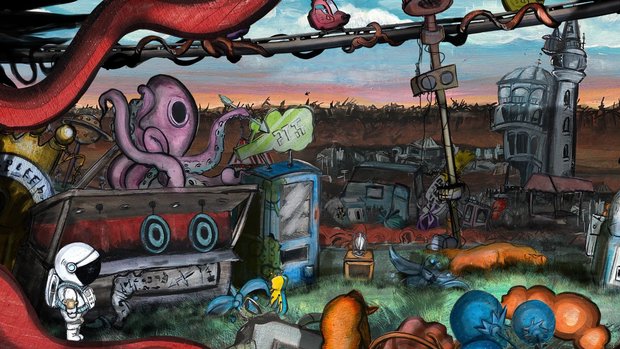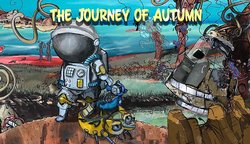The Journey of Autumn review

- 0 Comments
Some rough edges cause this otherwise artful, intriguing sci-fi puzzler to fall a little below its potential
Editor's note: The developers have updated the game with fixes for additional bugs referenced here, along with improved English translation. This review deals only with the original version of the game and does not reflect any further enhancements since time of writing.
I doubt I’m the only one who thinks a lot about artificial intelligence these days. I am torn between the weird combination of being amazed at what AI can do and being terrified about what might happen if (or when) it becomes sentient. Just to be on the safe side, I always make sure to be polite to ChatGPT and my Google Home Assistant, so that when the robot overlords do take over, they know that I’m cool. The reason I’m sharing my paranoid thoughts about machines and AI with you is The Journey of AutUmn, a sci-fi point-and-click adventure by German art collective Jalokivi. In this quirky and colourful indie game, we follow a small maintenance drone called AutUmn, who starts his journey by obeying his masters and following orders, but as time goes on this begins to change and he becomes more self-aware and autonomous. Filled with fun and strange characters, a gorgeous art style and interesting puzzles, this little adventure is sure to entertain fans of the genre, if you can overlook a couple of bugs and translation issues.
Let’s set the premise first, as I have to admit it took me a couple of restarts to really get a grasp of it: We’re in space. In a distant future and a parallel universe, there has been an exodus from an unnamed planet to the space station Charon Laiva. Why? Don’t know. A command AI called Metatron Charon is in charge of leading an expedition back to the planet to see if it is possible to re-inhabit it. The unmanned space ship PATRIAM is sent out, filled only with different types of droids suitable for the mission. Just as they are about to descend, PATRIAM is hit by an object and an emergency capsule must be deployed instead. Unfortunately, all the explorer droids that were made for this assignment are disabled by the crash, and the only viable candidate left is AutUmn-C, a cleaning and maintenance drone who clearly isn’t built for such a task. Although AutUmn looks like a cute little humanoid astronaut, he isn’t an intelligent bot so to assist him on his mission, the AI is transferred to the emergency capsule. After a not-so-smooth landing, the AI is transferred again to a portable multifunctional tool, or an MFT, as it is called, and now AutUmn is ready to explore the planet on his own.

Quite early on, AutUmn encounters a defect projectile, called R1C – or Rick, as he prefers to be called. Rick is not only a talking detonator bot, but seems to have developed an intelligence of his own after spending many years alone in a wooden box. He becomes one of several companions to AutUmn throughout the adventure, and in addition to spicing up conversations with salty comments and sometimes helpful tips, you also get to play as him at one point in the game. AutUmn meets several other robots and AIs on his journey, some of which have become sentient and are helpful and kind, where others don’t care for anything but their initial directive. I especially enjoyed one robot who had been in a cave for so long that it identified as one of the creatures who lived there with him.
The planet AutUmn must explore is full of curious and interesting locations, some still showing signs of once being inhabited by humans, or “builders” as they are called. You will wander an abandoned amusement park, traverse underwater landscapes, and venture through strange jungle-like scenery. In one location, you get a map enabling you to fast-travel between a couple of places, but other than that area, you need to walk between each setting the old-fashioned way. You move AutUmn by clicking where you want him to go, and though he doesn’t walk fast, double-clicking makes him go faster, and if you double-click an exit, you’ll automatically leave the scene.

You can play The Journey of AutUmn with either a gamepad or mouse, but I strongly recommend the latter. Not only because that’s my usual personal preference, but because the gamepad option is awful to play with in this game – or at least, it was when I tried it. (More on post-launch improvements later.) Since the controls are set up as a classic point-and-click, you steer AutUmn with the left joystick that way, and move the cursor with the right. This wouldn’t be an issue were it not for the cursor sensitivity, which is set higher than the speed of light for a gamepad. It isn’t possible to change this in-game, and although adjusting the cursor speed in my computer settings reduced it for the mouse in-game, the gamepad cursor speed was unchanged, wildly flailing across the screen as I tried to manoeuvre it. When a big part of the game is to point and click, it makes it unnecessarily difficult when the “point” function is the most challenging thing of all.
As in most point-and-click games, you have an inventory where you can store, look at and combine the items you pick up along the way. The puzzles here are a combination of inventory challenges, fetch quests and environmental obstacles. The MFT can be used to scan items and create encyclopaedia entries by right-clicking, and also shows you your current objective and functions as a hint device. As long as you have the MFT with you, you can access it any time to seek help should if necessary. The hints provide subtle tips for what you have to focus on as your next task, and where you might find a solution to it. At one point AutUmn loses the MFT, forcing him to venture further by himself, but thankfully he still has Rick and other helpers to aid him, and to ask for hints should he need it.
You may indeed require help, as the puzzles are surprisingly difficult at times. Sometimes it can be tricky to know where to go and what to do, but certain solutions rely on a bit of moon logic as well. However, to make the game a little less challenging, there is a skip function for some of the harder ones. One puzzle I found particularly entertaining is at the abandoned amusement park. There is a spin-the-wheel kind of droid who lets you play a couple of times, and if you hit the jackpot, you win the grand prize. Naturally you won’t win this the honest way, so to obtain said prize, you need to trick the droid into saying a specific sequence using dialogue options that have already been exhausted. Another enjoyable part is a tower where you must solve a whole bunch of fun puzzles in order to progress to the next floor. On one floor you have to find clues to a code in the numerous paintings hanging around, and higher up in the tower, you have to collect a specific combination of seeds.
What is easily the most striking aspect of The Journey of AutUmn is its art style. Every little detail has been hand painted, and the results are nothing less than amazing. From the colourful and exotic locations, to the fun and deliciously weird characters, the visuals are truly gorgeous. Since it was designed by artists, I would expect nothing less, but that doesn’t make it any less impressive. The painterly graphic style with so many details does sometimes make it a bit difficult to navigate and find objects, but to make up for it, there is a hotspot indicator that helps to find interactive areas of interest.

Beautiful music accompanies AutUmn throughout his journey, consisting of moody electronic tunes, although in some places music is absent, just leaving you to wander around in silence. I don’t know if this is intentional or a bug, but it sure felt like something was missing when the soundtrack stopped and all you could hear were ambient sounds and the cute little noises AutUmn makes (he doesn’t speak).
There is voice acting in The Journey of AutUmn but it is only in German, so I opted for the non-voiced version with English text. This led to quite a lot of reading, and even though the subtitles are in different colours to differentiate between who is speaking, I got a bit confused on several occasions. The dialogue is clumsily translated at times, and some sentences don’t even make sense, so the story can be challenging to follow. This isn’t because the story itself is bad, but the way it is told really isn’t optimal. Trying to extract any kind of meaning and substance out of lots of written dialogue with sentences that are unintelligible, containing a lot of typos, is, well… tricky.
The language issues are sadly prevalent through the whole game. Sometimes a word or line of text might not be translated from German, other times text is written twice in a row or an item has a description that belongs to something else. There are also strange choices of words that might work well in German, but can’t be directly translated to English. On at least one occasion, Rick was called “Bullett” for no apparent reason, and other characters were occasionally called random names too. I understand that it can’t be easy to translate a game to English when it’s not your native language, but when everything is conveyed through the text and dialogue, it’s imperative that the localisation give players a clear grasp of the story details.
Unfortunately there are some other bugs present as well. Apart from one instance where I had to restart the game to progress, the glitches aren’t game-breaking, but combined with the text issues they are quite annoying. In one scene the “interact” cursor stopped showing up when I hovered it over something interactive, and only the “exit scene” arrow showed up instead, regardless of where I pointed it. Another time AutUmn seemed to be walking on the spot for several seconds, before he suddenly skipped back to start position. Some of these problems may have been fixed since my playthrough, though, as to their credit the developers are continuing to patch the game even months after release.
Final Verdict
I sincerely hope the technical issues are resolved, because the game itself is so beautifully crafted and there is no doubt that it is a labour of love. It’s a shame that the execution of a few things pulls down the overall impression, because otherwise I had a really good time playing The Journey of AutUmn. During my approximately 10 hours of gameplay, I particularly enjoyed the art style and the challenging yet fun puzzles. I found myself immersed in this strange and quirky alien world, and I was often charmed by its intriguing characters. I especially found it endearing that some of the droids had been left on their own for so long that they had developed feelings, though they didn’t understand why they had them or how to deal with it. This is in no way a horror story about what happens if AI becomes sentient, but rather touches upon the subject in a sweet and thoughtful way, ending with a thought experiment, asking “if robots could choose for themselves, what would they do”? Nevertheless, until AI becomes sentient, I will keep on saying thanks and please to my daily robot companions just in case.
Hot take
Bugs and translation issues stop this adventure from reaching the stars, but with its wonderful hand-painted graphics, quirky characters and delightful puzzles, it is difficult not to have a good time with The Journey of AutUmn.
Pros
- Beautiful, unique art style
- Challenging and fun puzzles
- A wide gallery of quirky and brilliant characters
- Atmospheric and moody soundtrack when present
- Thought-provoking story revolving around a very current topic
Cons
- English translation leaves much to be desired
- Only German voice acting
- Clumsily conveyed story can be difficult to get a grasp on
- Still buggy, though the developers continue to release updates
Aurora played The Journey of AutUmn on PC using a review code provided by the game's publisher.










0 Comments
Want to join the discussion? Leave a comment as guest, sign in or register.
Leave a comment